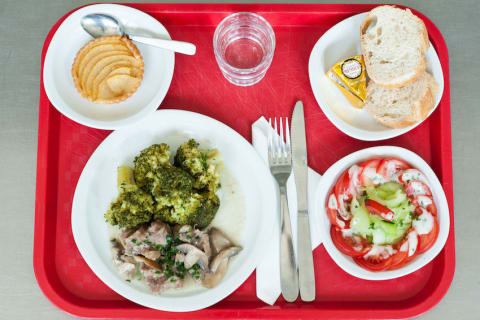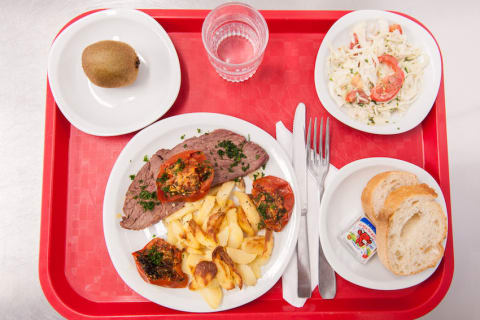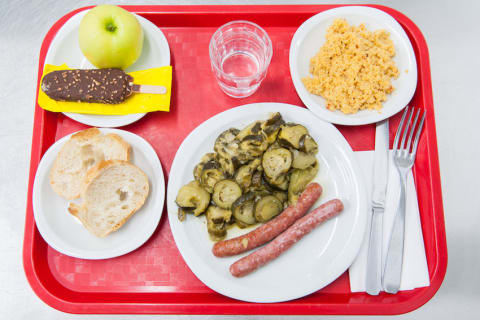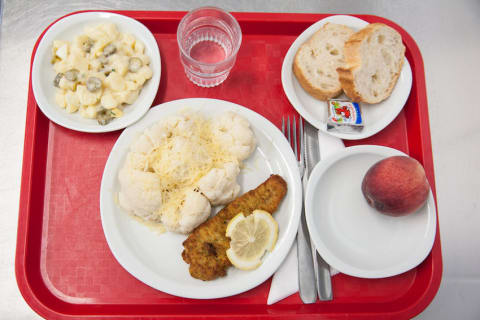What French Kids Eat For School Lunch (It Puts Americans To Shame!)

I walked into the dining room to see tables of four already set—silverware, silver breadbasket, off-white ceramic plates, cloth napkins, clear glasses, and water pitchers laid out ready for lunch. I was standing inside my children's public elementary school cafeteria, or "cantine" as the French call it, in our local town near Annecy, France. As part of my research into why French kids are better able to support healthy weight, the local city council gave me a tour of the public school's cantine and kitchen and let me ask any question that came to mind.
There are many theories as to why French people, and French children in particular, do not suffer from weight problems, obesity, diabetes, and hypertension like their American counterparts. Eating moderate quantities of fresh and freshly prepared food at set times of the day is definitely one of the most convincing reasons why. Daily exercise, in the form of three recess periods (two 15-minute and one 60-minute recess every day) and walking or biking to and from school, is another.
So what do French kids eat at school?
Menus are set up two months in advance by the cantine management staff and then sent to a certified dietitian who makes small "corrections." The dietitian might take out a small chocolate éclair and replace it with a kiwi for dessert if she thinks there's too much sugar that week. Or she may modify suggested menus by adding more or fewer carbohydrates, vegetables, fruits, or protein to keep the balance right.
Almost all foods are prepared right in the kitchen; they're not ready-made frozen. This means mashed potatoes, most desserts, salads, soups, and certainly the main dishes are prepared daily. Treats are included—the occasional slice of tart, a dollop of ice cream, a delicacy from the local pastry shop. (Check out these photos of a school lunch being prepared on premises.)
Below are photos and a description of one week's worth of school menus. Of note: French elementary school students don't go to school on Wednesdays, so that's why there are only four meals.
Monday

- First course: Cucumber and tomato salad
- Main course: Veal marinated with mushrooms, broccoli
- Cheese
- Dessert: Apple tart
Tuesday

- First course: Cabbage and tomato salad
- Main course: Roast beef, potatoes, baked tomatoes with herbs
- Cheese
- Dessert: Kiwi
Thursday

- First course: Tabouleh (made with bulgur)
- Main course: Sausages, zucchini
- Dessert: Ice cream, apple
Friday

- First course: Potato and pickle salad
- Main course: Breaded fish, cauliflower
- Cheese
- Dessert: Peach
Where does the food come from?
"All our fruits, vegetables, fish, and meat are sourced locally, some of them from local farms," according to Dany Cahuzac, the city counselor in charge of school matters, including the cantine. The local bakery delivers bread, a staple of every French meal, every morning. And every two days, there is at least one organic item on the menu. Once a month, an entirely organic meal is served. The only drink offered at lunchtime is filtered tap water, served in glass pitchers.
Just as important: how the kids eat.
As the children come streaming into the cantine, they sit down at tables of four that are already set and wait for older student volunteers to bring the first course to their table. The child who sits in the designated "red" chair is the only one who is allowed to get up to fetch more water in the pitcher, extra bread for the breadbasket, or to ask for extra food for the table. After finishing the first course (often a salad), volunteers bring the main course platter to the table and the children serve themselves. A cheese course follows (often a yogurt or small piece of Camembert, for example), and then dessert (more often than not, fresh fruit).
"Eating a balanced meal while sitting down calmly is important in the development of a healthy child," adds Cahuzac. "It helps them to digest food properly, avoid stomachaches, and avoid sapped energy levels in the afternoon."
What about exercise?
What the French specialize in is moving all the time, not just during gym class. For example, elementary-age students throughout the country have three set recess periods during the day: a 15-minute run-around in the morning, a 60-minute recess after lunch, and another 15-minute break in the afternoon. On top of these designated times, children are encouraged to walk and bike to school, although this depends largely on the proximity of home to school. Bicycle parking spaces are usually all used up in the morning at our local school, and while younger students ride to school next to an adult, the older fifth graders often cycle on their own.
Aside from two hourlong periods of gym during the week, kids often walk during school outings and field trips (which can include anything from an hour to the local library, a visit to local farms, to the lakeside for paddleboard lessons, or a hike up a local mountain). Walking is emphasized at even younger ages—indeed 3- and 4-year-olds in preschool will walk up to 2 kilometers in an afternoon to go visit the local library. Sometimes they walk to the local retirement home to sing songs for the elderly. Elementary-age schoolchildren in the big French cities walk just as much — it's often easier for them because of sidewalks.
"Even the youngest children in preschool walk together every week," explains Cahuzac. "Those who want to complain usually just follow the pack and eventually get in the habit of walking."
Making the French attitude work for us, too.
So what can we do to promote better eating and moving habits for our children stateside? It all starts at home: We know what healthy foods are, and we need to use our positive influence to feed our kids healthier foods and teach healthy eating by example. Home-cooked meals based on plenty of fresh produce, and a weekly family walk, hike, or game of tag are simple lifestyle habits that make a difference in a child's life over time.
What about school? Two suggestions: If healthy options are not available in your school, get in the habit of packing a healthy lunch for your child and boycott the cafeteria's fast foods. Then, reach out to local, state, and national elected officials and demand better nutrition in your school.

Rebeca Plantier is a journalist and author of French School Lunch, a two-year research project on France’s public school lunch program promoting health and wellbeing in children. She writes about about healthy living, travel, parenting and the French lifestyle—and her work has appeared on various sites, such as Huffington Post, Business Insider, Salon, EatLocalGrown, travel site Matador Network and many others. Find her at rebecaplantier.com.